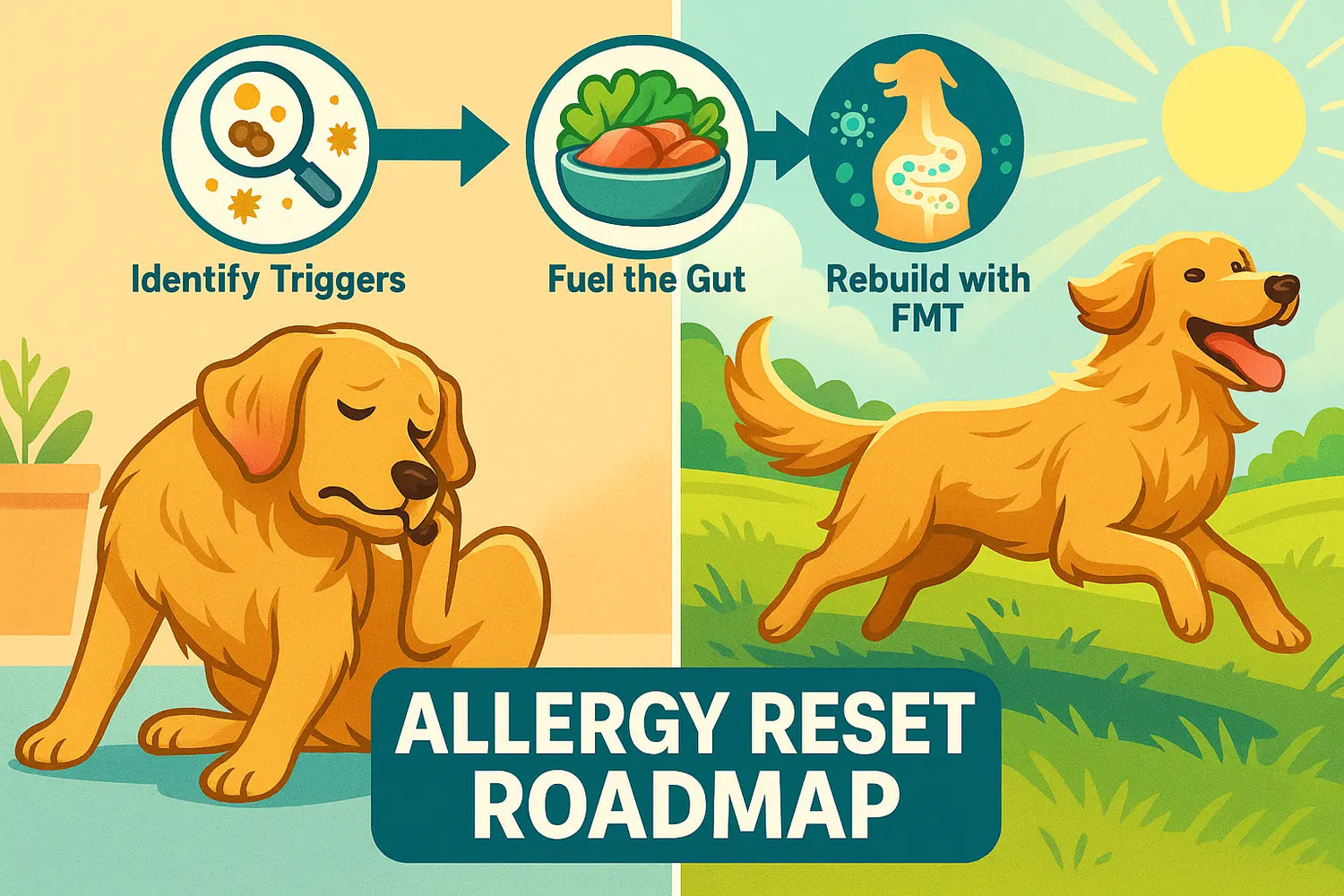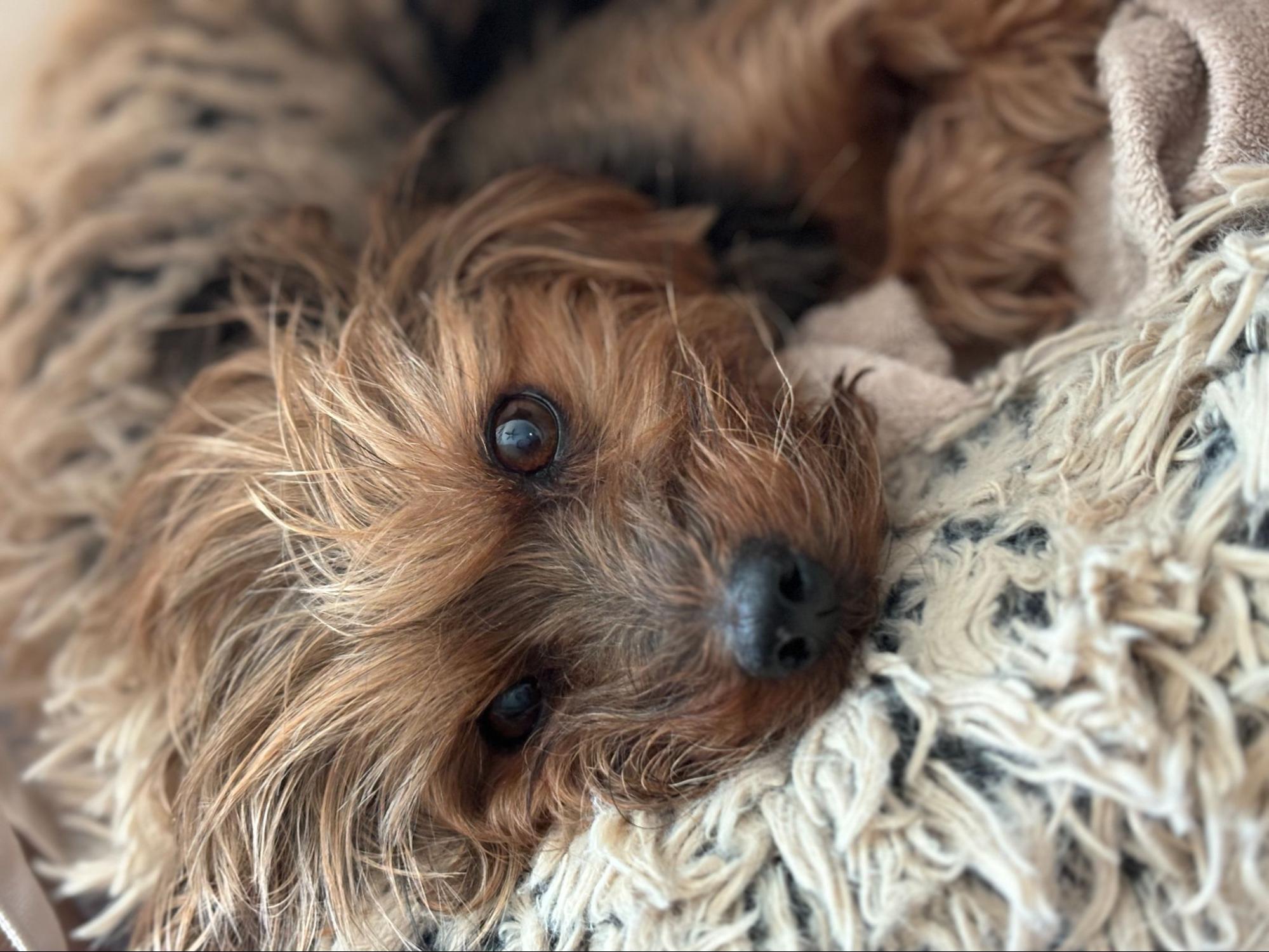Stop Fighting the Symptoms: Understand the 3-Step Allergy Reset Roadmap to Calm Histamine Chaos, Repair Leaky Gut, and Retrain Your Pet’s Immune System.
We’ve all heard the story: the itchy dog who’s “allergic to everything”—plagued by ear infections and digestive meltdowns that flare up out of nowhere. Or the cat with mystery rashes who’s licked a bald spot on her hind end.
The default answer?
Blame the pollen. Prescribe Apoquel. Try another hydrolyzed protein. Hope for the best.
But what if the problem isn’t outside your pet’s body?
What if it starts deep inside… with a leaky gut and an immune system that’s been fighting a losing battle?
As a Holistict Pet Health Coach and Canine Nutritionist who’s lived this firsthand with my dog Darla, I’m here to tell you:
Before we can win the allergy war, we have to bring peace to the gut.
Allergies are not just skin deep.
They are gut-deep. They start where the immune system (the GUT) learns how to respond to the world. And the real drivers behind that process?
-
Histamine
-
DAO (diamine oxidase)
- GALT (gut-associated lymphoid tissue)
Let’s break this down—because when you understand the why, the healing path becomes clear.
Leaky Gut: The Doorway to Immune Chaos
How does all of this happen? It starts with a compromised gut lining—what we call leaky gut, or intestinal permeability. The gut lining is made up of tightly packed epithelial cells that act as a gatekeeper—absorbing nutrients, blocking invaders.
When that barrier becomes compromised, we get intestinal permeability, or leaky gut. This allows toxins, bacteria, and partially digested food to “leak” into the bloodstream and trigger inflammation.
Common causes include:
-
Heat-processed, high-carb kibble
-
Antibiotics (they can take out the good guys too) and NSAIDs
-
Vaccines, stress, environmental toxins
- Dysbiosis (imbalance of gut flora)
Leaky gut sets the stage for immune confusion, histamine overload, and allergic symptoms. Now, proteins and bacterial fragments leak through—and the body starts to see them as invaders.
Why? This is where things get really interesting.

GALT: Your Pet’s Inner Allergy Radar
70–80% of your pet’s immune system lives in the gut. That’s because of something called GALT—Gut-Associated Lymphoid Tissue. Think of GALT like the immune system’s training ground, embedded in the gut lining.
It teaches immune cells what to attack and what to ignore and its constantly surveying what passes through—food, microbes, environmental particles—and deciding what’s safe and what’s not.
In a healthy gut, GALT says:
- “Chicken? Good.”
- “Grass? Fine.”
- “Dust? No big deal.”
But in a leaky or inflamed gut, GALT goes haywire. It starts overreacting to harmless things. That’s when we start seeing food intolerances, chronic inflammation, and a pet that’s “allergic to everything.”
That’s exactly what happened to Darla. It began with mild itching—some paw licking, ear scratching, nothing major. But over time, her immune system started reacting more and more… until one windy afternoon:
Darla’s GALT: “Should we ignore that pollen…or send a full-blown inflammatory response?”
It chose violence.
She broke out in full-body hives. No new food. No chemical exposure. Just the wind.
At the time Darla was on kibble, had been through rounds of antibiotics, and her gut was inflamed. Later, a food intolerance test came back red in nearly every category.
But it wasn’t that she was truly allergic to all foods—it was that her immune system had lost the ability to tell the difference between safe and harmful.
GALT was panicking. And her skin, ears, and nervous system were paying the price.
In a healthy gut, GALT keeps things calm and discerning. In a leaky, inflamed gut, GALT becomes confused, hypersensitive, and easily triggered.
This is also why food sensitivities often develop later in life. It’s not that your pet suddenly became allergic to turkey—it’s that their GALT lost its regulatory compass. And why allergies can be so hard to shut off.

Histamine: Not the Enemy—Just the Messenger
So where does histamine come in? We think of histamine as the enemy—the cause of itchy skin, red ears, sneezing, and the dreaded hives.
But histamine is actually a normal part of the body’s communication system. In normal amounts it’s helpful and contributes to regulating digestion, immune response, and even brain function.
But when the immune system is firing constantly—like in a pet with leaky gut—their bodies can’t clear it fast enough and we get histamine overload.
This can look like:
- Red, inflamed, itchy skin
- Hives or rashes
- Ear infections
- Sneezing or wheezing
- Digestive upset
- Anxiety or hyper-alertness (Histamine isn’t just an allergy chemical—it also acts as a neurotransmitter in the brain, affecting alertness, mood, and even anxiety)
This histamine buildup is often gut-driven, not “just skin allergies.”
DAO: The Histamine Gatekeeper
So why couldn’t Darla—and so many other pets—handle histamine? The answer may lie with DAO, or diamine oxidase.
This is the primary enzyme responsible for breaking down histamine in the gut. If there’s not enough DAO, histamine sticks around, builds up, and starts causing chaos.
Here’s the twist: DAO is produced in the cells that line the gut. So if your pet’s gut is leaky or damaged… DAO production plummets. That means histamine builds up and stays active longer than it should.
And here’s where the microbiome makes or breaks the cycle:
❌ Histamine-Producing Bacteria (often overgrown in dysbiosis):
- Lactobacillus casei
- Enterococcus faecalis
- Klebsiella
- Morganella morganii
✅ Histamine-Degrading or Modulating Bacteria (often missing):
- Bifidobacterium infantis
- Bifidobacterium longum
- Lactobacillus rhamnosus
- Bacillus subtilis (a soil-based spore)
When the gut is overrun by the wrong microbes and DAO is depleted, even normal levels of histamine can trigger intense symptoms when clearance is impaired.
Fueling the Gut’s Peacekeepers: SCFAs and Allergy Recovery
By now, we know that your pet’s immune system—specifically GALT—has been in overdrive, reacting to harmless things like food or pollen as if they were invaders.
Meanwhile, histamine is flooding the system, and DAO, the enzyme meant to keep histamine in check, can’t keep up.
What’s missing? A peace treaty.
And that treaty is brokered by the gut’s short-chain fatty acids (SCFAs)—specifically butyrate, acetate, and propionate.
These powerful postbiotics are produced when beneficial microbes ferment dietary fibers in the colon.
But SCFAs do more than just nourish the gut lining—they act as mediators at the immune table, helping DAO, histamine, and GALT find balance instead of war.
SCFAs help:
- Repair and seal the gut lining (ending the cycle of leaky gut)
- Support DAO production, so histamine can be cleared naturally
- Reduce mast cell activation (a major histamine source)
- Activate regulatory T cells, which teach GALT how to tolerate, not attack
Without enough SCFAs, there’s no truce. GALT keeps launching immune assaults. Histamine keeps building. DAO falls behind.
But with the right microbial support, SCFAs restore the signals that keep your pet’s immune system grounded.

The Allergy Reset Roadmap: A 3-Step System for Lasting Relief
Here’s my approach as a Certified Holistic Pet Health Coach and Canine Nutritionist—and one I’ve seen work again and again:
Step 1: Identify the Triggers Keeping the Gut on Alert
Before healing can begin, we need to quiet the immune system—to remove the inputs it currently sees as invaders, so the body can stop fighting and start repairing.
This is where testing comes in. There are many tools available, but two I often recommend—and have used personally and with clients—are:
NutriScan (by Dr. Jean Dodds), which measures IgA and IgM antibodies to common foods, revealing delayed immune responses driven by gut inflammation.
Glacier Peak Holistics Stress Scan, a bioresonance scan that highlights energetic sensitivities to foods, environmental stressors, and toxins—useful especially for pets not yet showing antibody activity but clearly reacting.
Whether via antibodies or energy fields, these tests help us identify what’s currently triggering immune confusion. It’s not about labeling these foods or exposures as “bad”—it’s about pressing pause.
We remove them temporarily, so GALT can calm down and FMT can work on microbial balance. Once peace is restored, many of these foods can often be reintroduced.
Step 2: Fuel the Gut, Not the Fire
The next step is an anti-inflammatory diet that supports healing instead of fueling more reactions. This is where we shift to novel proteins and ingredients your pet’s immune system hasn’t seen before…whatever wasn’t flagged on your pet’s testing.
Also, we need to ditch the kibble. Kibble—even the “hydrolyzed prescription” kind—is heavily processed, pro-inflammatory, and loaded with starchy fillers that disrupt the gut microbiome.
Hydrolyzed kibble is often recommended for pets with allergies because the proteins are broken down to reduce immune reactions.
But here’s the truth: hydrolyzed kibble just kicks the can down the road.
If we want to stop the cycle, we have to rebuild the gut—not keep silencing it.
To make this part easy and effective, I often guide clients toward Dr. Judy Morgan’s Pup Loaf or Dr. Ruth Roberts’ CrockPet Diet—both of which can be tailored to fit your pet’s current needs and sensitivities.
💡 Dr. Judy Morgan
💡 Dr. Ruth Roberts
The key here is calming the immune system. You can’t rebuild tolerance while the gut is still reacting to every meal. This phase helps dial down inflammation, support digestion, and give your pet the nourishment they need to move forward into real healing.
Step 3: Rebuild with FMT – Turning the Battlefield into Balance
This is where real healing begins.
After removing triggers and feeding the microbiome, the —and most critical—step is rebuilding. But you can’t rebuild an ecosystem with just a few strains of probiotics. You need the whole village.
Fecal Microbiota Transplantation (FMT) is the only method we have that restores a complete, living microbial community. It’s not a supplement—it’s a reboot.
A full microbial download from a healthy donor that delivers everything your pet’s gut has been missing.
Where probiotics pass through, Legacy Biome FMT engrafts. It takes root, colonizes, and reshapes the terrain—restoring balance at the source.
The new microbes begin producing short-chain fatty acids (SCFAs), reducing inflammation, repairing the gut lining, and communicating with GALT to re-educate the immune system.
Histamine-producing strains are outnumbered by peacekeepers. DAO production begins to rise. The gut wall starts sealing.
What was once a battlefield of overreaction—itchy skin, chronic infections, endless inflammation—becomes something else entirely: balance.
- The wind blows, and your dog doesn’t break out in hives.
- A new food is introduced, and nothing flares.
- That’s not suppression. That’s resilience. Legacy Biome FMT gave Darla that second chance. And it can do the same for pets still stuck in the loop of immune confusion.
When we rebuild from the inside out, we don’t just treat allergies.
We train the immune system to stop fighting… and start living.
Pawsitive Vibes!
Melissa




Leave a comment
This site is protected by hCaptcha and the hCaptcha Privacy Policy and Terms of Service apply.